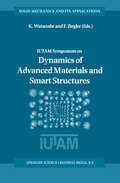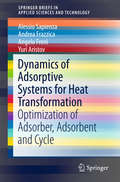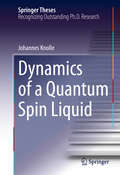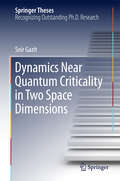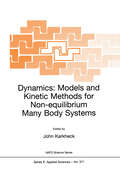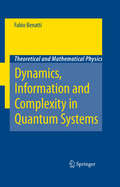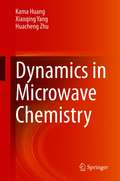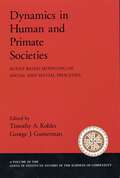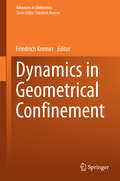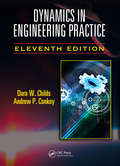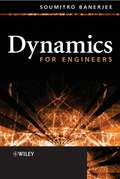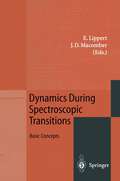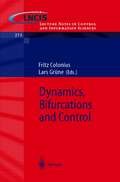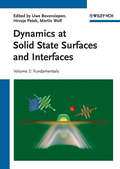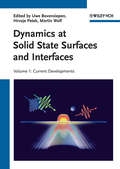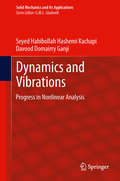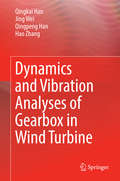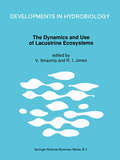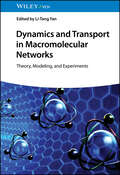- Table View
- List View
The Dynamics of Arthopod Predator-Prey Systems. (Monographs in Population Biology #111)
by Michael Patrick HassellIn this study of arthropod predador-prey systems Michael Hassell shows how many of the components of predation may be simply modeled in order to reveal their effects on the overall dynamics of the interacting populations. Arthropods, particularly insects, make ideal subjects for such a study because their generation times are characteristically short and many have relatively discrete generations, inviting the use of difference equation models to describe population changes. Using analytical models framed in difference equations, Dr. Hassell is able to show how the detailed biological processes of insect predator-prey (including host-parasitoid) interactions may be understood. Emphasizing the development and subsequent stability analysis of general models, the author considers in detail several crucial components of predator-prey models: the prey's rate of increase as a function of density, non-random search, mutual interference, and the predator's rate of increase as a function of predator survival and fecundity. Drawing on the correspondence between the models and field and laboratory data, Dr. Hassell then discusses the practical implications for biological pest control and suggests how such models may help to formulate a theoretical basis for biological control practices.
Dynamics of Advanced Materials and Smart Structures (Solid Mechanics and Its Applications #106)
by Kazumi Watanabe Franz ZieglerTwo key words for mechanical engineering in the future are Micro and Intelligence. It is weIl known that the leadership in the intelligence technology is a marter of vital importance for the future status of industrial society, and thus national research projects for intelligent materials, structures and machines have started not only in advanced countries, but also in developing countries. Materials and structures which have self-sensing, diagnosis and actuating systems, are called intelligent or smart, and are of growing research interest in the world. In this situation, the IUT AM symposium on Dynamics 0/ Advanced Materials and Smart Structures was a timely one. Smart materials and structures are those equipped with sensors and actuators to achieve their designed performance in achanging environment. They have complex structural properties and mechanical responses. Many engineering problems, such as interface and edge phenomena, mechanical and electro-magnetic interaction/coupling and sensing, actuating and control techniques, arise in the development ofintelligent structures. Due to the multi-disciplinary nature ofthese problems, all ofthe classical sciences and technologies, such as applied mathematics, material science, solid and fluid mechanics, control techniques and others must be assembled and used to solve them. IUTAM weIl understands the importance ofthis emerging technology. An IUTAM symposium on Smart Structures and Structronic Systems (Chaired by U.
Dynamics of Adsorptive Systems for Heat Transformation: Optimization of Adsorber, Adsorbent and Cycle (SpringerBriefs in Applied Sciences and Technology)
by Alessio Sapienza Andrea Frazzica Angelo Freni Yuri AristovThis book investigates the adsorption dynamics of water, methanol, ethanol, and ammonia vapor on loose and consolidated adsorbent beds, as well as the impact of this aspect on the overall performance of adsorption systems for heat transformation. In particular, it presents the results of kinetic measurements made using the large temperature jump (LTJ) method, the most efficient way to study adsorption dynamics under realistic operating conditions for adsorptive heat transformers. The information provided is especially beneficial for all those working on the development of novel adsorbent materials and advanced adsorbers for heating and cooling applications. Today, technologies and systems based on adsorption heat transformation (AHT) processes offer a fascinating option for meeting the growing worldwide demand for air conditioning and space heating. Nevertheless, considerable efforts must still be made in order to enhance performance so as to effectively compete with commonly used electrical compression and absorption machines. For this purpose, intelligent design for adsorption units should above all focus on finding a convenient choice of adsorbent material by means of a comprehensive analysis that takes into account both thermodynamic and dynamic aspects. While the thermodynamic properties of the AHT cycle have been studied extensively, the dynamic optimization of AHT adsorbers is still an open issue. Several efforts have recently been made in order to analyze AHT dynamics, which greatly influence overall AHT performance.
Dynamics of a Quantum Spin Liquid (Springer Theses)
by Johannes KnolleThis thesis presents an exact theoretical study of dynamical correlation functions in different phases of a two-dimensional quantum spin liquid. By calculating the dynamical spin structure factor and the Raman scattering cross section, this thesis shows that there are salient signatures—qualitative and quantitative—of the Majorana fermions and the gauge fluxes emerging as effective degrees of freedom in the exactly solvable Kitaev honeycomb lattice model. The model is a representative of a class of spin liquids with Majorana fermions coupled to Z2 gauge fields. The qualitative features of the response functions should therefore be characteristic for this broad class of topological states.
Dynamics Near Quantum Criticality in Two Space Dimensions (Springer Theses)
by Snir GazitThis work addresses dynamical aspects of quantum criticality in two space dimensions. It probes two energy scales: the amplitude (Higgs) mode, which describes fluctuations of the order parameter amplitude in the broken symmetry phase and the dual vortex superfluid stiffness. The results demonstrate that the amplitude mode can be probed arbitrarily close to criticality in the universal line shape of the scalar susceptibility and the optical conductivity. The hallmark of quantum criticality is the emergence of softening energy scales near the phase transition. In addition, the author employs the charge-vortex duality to show that the capacitance of the Mott insulator near the superfluid to insulator phase transition serves as a probe for the dual vortex superfluid stiffness. The numerical methods employed are described in detail, in particular a worm algorithm for O(N) relativistic models and methods for numerical analytic continuation of quantum Monte Carlo data. The predictions obtained are particularly relevant to recent experiments in cold atomic systems and disordered superconductors.
Dynamics: Models and Kinetic Methods for Non-equilibrium Many Body Systems (NATO Science Series E: #371)
by John KarkheckRecent years have witnessed a resurgence in the kinetic approach to dynamic many-body problems. Modern kinetic theory offers a unifying theoretical framework within which a great variety of seemingly unrelated systems can be explored in a coherent way. Kinetic methods are currently being applied in such areas as the dynamics of colloidal suspensions, granular material flow, electron transport in mesoscopic systems, the calculation of Lyapunov exponents and other properties of classical many-body systems characterised by chaotic behaviour. The present work focuses on Brownian motion, dynamical systems, granular flows, and quantum kinetic theory.
Dynamics, Information and Complexity in Quantum Systems: (pdf) (Theoretical and Mathematical Physics)
by Fabio BenattiDynamics, Information and Complexity in Quantum Systems (Theoretical and Mathematical Physics)
by Fabio BenattiThis second edition of Dynamics, Information and Complexity in Quantum Systems widens its scope by focussing more on the dynamics of quantum correlations and information in microscopic and mesoscopic systems, and their use for metrological and machine learning purposes. The book is divided into three parts: Part One: Classical Dynamical SystemsAddresses classical dynamical systems, classical dynamical entropy, and classical algorithmic complexity.Includes a survey of the theory of simple perceptrons and their storage capacity. Part Two: Quantum Dynamical SystemsFocuses on the dynamics of entanglement under dissipative dynamics and its metrological use in finite level quantum systems.Discusses the quantum fluctuation approach to large-scale mesoscopic systems and their emergent dynamics in quantum systems with infinitely many degrees of freedom.Introduces a model of quantum perceptron whose storage capacity is computed and compared with the classical one. Part Three: Quantum Dynamical Entropies and ComplexitiesDevoted to quantum dynamical entropies and algorithmic complexities. This book is meant for advanced students, young and senior researchers working in the fields of quantum statistical mechanics, quantum information, and quantum dynamical systems. It is self-contained, and the only prerequisites needed are a standard knowledge of statistical mechanics, quantum mechanics, and linear operators on Hilbert spaces.
Dynamics in Microwave Chemistry
by Kama Huang Xiaoqing Yang Huacheng ZhuThis book addresses microwave chemistry at both the physical and molecular level. Its main goal is to elaborate the highly complex scientific issues involved in the fundamental theory of microwave chemistry, and in industrialized applications in the near future.The book provides detailed insights into the characterization and measurement of dielectric properties under complex conditions, such as chemical reactions, high-temperature environments, etc. Considerable attention is paid to the theory of dynamics in microwave chemistry, from the view of both physical level and molecular level. Microwave-Material Interactions simulation is used for physical dynamical analysis, while a Microwave-Molecules Interactions methodology is proposed for molecular dynamical analysis. In turn, calculational examples are introduced for better description and validation, respectively. Lastly, the book proposes design strategies and calculational examples for large-scale application.Richly illustrated and including a wealth of worked-out examples, this book is ideal for all researchers, students and engineers who are just getting started in the dynamics of microwave chemistry.
Dynamics in Human and Primate Societies: Agent-Based Modeling of Social and Spatial Processes (Santa Fe Institute Studies on the Sciences of Complexity)
by Timothy A. Kohler George G. GumermanAs part of the SFI series, this book presents the most up-to-date research in the study of human and primate societies, presenting recent advances in software and algorithms for modeling societies. It also addresses case studies that have applied agent-based modeling approaches in archaeology, cultural anthropology, primatology, and sociology. Many things set this book apart from any other on modeling in the social sciences, including the emphasis on small-scale societies and the attempts to maximize realism in the modeling efforts applied to social problems and questions. It is an ideal book for professionals in archaeology or cultural anthropology as well as a valuable tool for those studying primatology or computer science.
Dynamics in Geometrical Confinement (Advances in Dielectrics)
by Friedrich KremerThis book describes the dynamics of low molecular weight and polymeric molecules when they are constrained under conditions of geometrical confinement. It covers geometrical confinement in different dimensionalities:(i) in nanometer thin layers or self supporting films (1-dimensional confinement)(ii) in pores or tubes with nanometric diameters (2-dimensional confinement)(iii) as micelles embedded in matrices (3-dimensional) or as nanodroplets.The dynamics under such conditions have been a much discussed and central topic in the focus of intense worldwide research activities within the last two decades. The present book discusses how the resulting molecular mobility is influenced by the subtle counterbalance between surface effects (typically slowing down molecular dynamics through attractive guest/host interactions) and confinement effects (typically increasing the mobility). It also explains how these influences can be modified and tuned, e.g. through appropriate surface coatings, film thicknesses or pore diameters. "Dynamics in Confinement" sums up the present state-of-the-art and introduces to the analytical methods of choice for the study of dynamics in nanometer-scale confinement.
Dynamics in Enzyme Catalysis (Topics in Current Chemistry #337)
by Judith Klinman and Sharon Hammes-SchifferChristopher M. Cheatum and Amnon Kohen, Relationship of Femtosecond–Picosecond Dynamics to Enzyme-Catalyzed H-Transfer. Cindy Schulenburg and Donald Hilvert, Protein Conformational Disorder and Enzyme Catalysis. A. Joshua Wand, Veronica R. Moorman and Kyle W. Harpole, A Surprising Role for Conformational Entropy in Protein Function. Travis P. Schrank, James O. Wrabl and Vincent J. Hilser, Conformational Heterogeneity Within the LID Domain Mediates Substrate Binding to Escherichia coli Adenylate Kinase: Function Follows Fluctuations. Buyong Ma and Ruth Nussinov, Structured Crowding and Its Effects on Enzyme Catalysis. Michael D. Daily, Haibo Yu, George N. Phillips Jr and Qiang Cui, Allosteric Activation Transitions in Enzymes and Biomolecular Motors: Insights from Atomistic and Coarse-Grained Simulations. Karunesh Arora and Charles L. Brooks III, Multiple Intermediates, Diverse Conformations, and Cooperative Conformational Changes Underlie the Catalytic Hydride Transfer Reaction of Dihydrofolate Reductase. Steven D. Schwartz, Protein Dynamics and the Enzymatic Reaction Coordinate.
Dynamics in Engineering Practice (Applied and Computational Mechanics)
by Dara W. Childs Andrew P. ConkeyObserving that most books on engineering dynamics left students lacking and failing to grasp the general nature of dynamics in engineering practice, the authors of Dynamics in Engineering Practice, Eleventh Edition focused their efforts on remedying the problem. This text shows readers how to develop and analyze models to predict motion. While esta
Dynamics in Engineering Practice (Applied and Computational Mechanics)
by Dara W. Childs Andrew P. ConkeyObserving that most books on engineering dynamics left students lacking and failing to grasp the general nature of dynamics in engineering practice, the authors of Dynamics in Engineering Practice, Eleventh Edition focused their efforts on remedying the problem. This text shows readers how to develop and analyze models to predict motion. While esta
Dynamics for Engineers
by Soumitro BanerjeeModelling and analysis of dynamical systems is a widespread practice as it is important for engineers to know how a given physical or engineering system will behave under specific circumstances. This text provides a comprehensive and systematic introduction to the methods and techniques used for translating physical problems into mathematical language, focusing on both linear and nonlinear systems. Highly practical in its approach, with solved examples, summaries, and sets of problems for each chapter, Dynamics for Engineers covers all aspects of the modelling and analysis of dynamical systems. Key features: Introduces the Newtonian, Lagrangian, Hamiltonian, and Bond Graph methodologies, and illustrates how these can be effectively used for obtaining differential equations for a wide variety of mechanical, electrical, and electromechanical systems. Develops a geometric understanding of the dynamics of physical systems by introducing the state space, and the character of the vector field around equilibrium points. Sets out features of the dynamics of nonlinear systems, such as like limit cycles, high-period orbits, and chaotic orbits. Establishes methodologies for formulating discrete-time models, and for developing dynamics in discrete state space. Senior undergraduate and graduate students in electrical, mechanical, civil, aeronautical and allied branches of engineering will find this book a valuable resource, as will lecturers in system modelling, analysis, control and design. This text will also be useful for students and engineers in the field of mechatronics.
Dynamics During Spectroscopic Transitions: Basic Concepts
by Ernst Lippert J. D. Macomber"How does a photon get into an atom?" This question - fundamental to quantum mechanics - puzzled leading scientists such as Schrödinger and Heisenberg and is still asked by students. James D. Macomber's book was the first to provide a didactic and unified approach to the answer, which has now been updated by way of recent experimental results and modern theoretical interpretations written by leading scientists. It provides an understanding for similarities among the spectroscopic methods available and is stimulating to read, reflecting the excitement of scientific research.
Dynamics, Bifurcations and Control (Lecture Notes in Control and Information Sciences #273)
by Fritz Colonius Lars GrüneThis volume originates from the Third Nonlinear Control Workshop "- namics, Bifurcations and Control", held in Kloster Irsee, April 1-3 2001. As the preceding workshops held in Paris (2000) and in Ghent (1999), it was organized within the framework of Nonlinear Control Network funded by the European Union (http://www.supelec.fr/lss/NCN). The papers in this volume center around those control problems where phenomena and methods from dynamical systems theory play a dominant role. Despite the large variety of techniques and methods present in the c- tributions, a rough subdivision can be given into three areas: Bifurcation problems, stabilization and robustness, and global dynamics of control s- tems. A large part of the fascination in nonlinear control stems from the fact that is deeply rooted in engineering and mathematics alike. The contributions to this volume reflect this double nature of nonlinear control. We would like to take this opportunity to thank all the contributors and the referees for their careful work. Furthermore, it is our pleasure to thank Franchise Lamnabhi-Lagarrigue, the coordinator of our network, for her s- port in organizing the workshop and the proceedings and for the tremendous efforts she puts into this network bringing the cooperation between the d- ferent groups to a new level. In particular, the exchange and the active p- ticipation of young scientists, also reflected in the Pedagogical Schools within the Network, is an asset for the field of nonlinear control.
Dynamics at Solid State Surfaces and Interfaces: Volume 2: Fundamentals
by Uwe Bovensiepen Hrvoje Petek Martin WolfThis two-volume work covers ultrafast structural and electronic dynamics of elementary processes at solid surfaces and interfaces, presenting the current status of photoinduced processes. Providing valuable introductory information for newcomers to this booming field of research, it investigates concepts and experiments, femtosecond and attosecond time-resolved methods, as well as frequency domain techniques. The whole is rounded off by a look at future developments.
Dynamics at Solid State Surfaces and Interfaces: Volume 1 - Current Developments
by Uwe Bovensiepen Hrvoje Petek Martin WolfThis two-volume work covers ultrafast structural and electronic dynamics of elementary processes at solid surfaces and interfaces, presenting the current status of photoinduced processes. Providing valuable introductory information for newcomers to this booming field of research, it investigates concepts and experiments, femtosecond and attosecond time-resolved methods, as well as frequency domain techniques. The whole is rounded off by a look at future developments.
Dynamics at Solid State Surfaces and Interfaces: Volume 2: Fundamentals
by Uwe Bovensiepen Hrvoje Petek Martin WolfThis two-volume work covers ultrafast structural and electronic dynamics of elementary processes at solid surfaces and interfaces, presenting the current status of photoinduced processes. Providing valuable introductory information for newcomers to this booming field of research, it investigates concepts and experiments, femtosecond and attosecond time-resolved methods, as well as frequency domain techniques. The whole is rounded off by a look at future developments.
Dynamics at Solid State Surfaces and Interfaces: Volume 1 - Current Developments
by Martin Wolf Hrvoje Petek Uwe BovensiepenThis two-volume work covers ultrafast structural and electronic dynamics of elementary processes at solid surfaces and interfaces, presenting the current status of photoinduced processes. Providing valuable introductory information for newcomers to this booming field of research, it investigates concepts and experiments, femtosecond and attosecond time-resolved methods, as well as frequency domain techniques. The whole is rounded off by a look at future developments.
Dynamics and Vibrations: Progress in Nonlinear Analysis (Solid Mechanics and Its Applications #202)
by Seyed Habibollah Kachapi Davood Domairry GanjiDynamical and vibratory systems are basically an application of mathematics and applied sciences to the solution of real world problems. Before being able to solve real world problems, it is necessary to carefully study dynamical and vibratory systems and solve all available problems in case of linear and nonlinear equations using analytical and numerical methods. It is of great importance to study nonlinearity in dynamics and vibration; because almost all applied processes act nonlinearly, and on the other hand, nonlinear analysis of complex systems is one of the most important and complicated tasks, especially in engineering and applied sciences problems. There are probably a handful of books on nonlinear dynamics and vibrations analysis. Some of these books are written at a fundamental level that may not meet ambitious engineering program requirements. Others are specialized in certain fields of oscillatory systems, including modeling and simulations. In this book, we attempt to strike a balance between theory and practice, fundamentals and advanced subjects, and generality and specialization. None of the books in this area have completely studied and analyzed nonlinear equation in dynamical and vibratory systems using the latest analytical and numerical methods, so that the user can solve the problems without the need of studying too many different references. Thereby in this book, by the use of the latest analytic, numeric laboratorial methods and using more than 300 references like books, papers and the researches done by the authors and by considering almost all possible processes and situation, new theories has been proposed to encounter applied problems in engineering and applied sciences. In this way, the user (bachelor’s, master’s and PhD students, university teachers and even in research centers in different fields of mechanical, civil, aerospace, electrical, chemical, applied mathematics, physics, and etc.) can encounter such systems confidently. In the different chapters of the book, not only are the linear and especially nonlinear problems with oscillatory form broadly discussed, but also applied examples are practically solved by the proposed methodology.
Dynamics and Vibration Analyses of Gearbox in Wind Turbine
by Qingkai Han Jing Wei Qingpeng Han Hao ZhangThis book explores the dynamics and vibration properties of gearboxes, with a focus on geared rotor systems. It discusses mechanical theories, finite-element based simulations, experimental measurements and vibration signal processing techniques.It introduces the vibration-resonance calculation method for the geared rotor system in wind turbines and load sharing of the planetary gear train, and offers a method for calculating the vibrations of geared rotor systems under either internal excitations from gear sets or external loads transferred from wind loads. It also defines and elaborates on parameter optimization for planetary gear systems based on the torsional dynamics of wind-turbine geared rotor systems. Moreover, it describes experimental measurements of vibrations on the wind-turbine gearbox performed on the test rig and on site, and analyzes the vibration signals of different testing points, showing them in both time and frequency domains. Lastly, it lists the gear coupling frequencies and fault characteristic frequencies from the vibrations of the gearbox housing. The technologies and results presented are valuable resources for use in dynamic design, vibration prediction and analysis of gearboxes and geared rotor systems in wind turbines as well as many other machines.
The Dynamics and Use of Lacustrine Ecosystems: Proceedings of the 40-Year Jubilee Symposium of the Finnish Limnological Society, held in Helsinki, Finland, 6–10 August 1990 (Developments in Hydrobiology #79)
by V. Ilmavirta R. I. JonesLimnology is increasingly concerned with water supply and the relation of man to aquatic environments. Without the continued availability of pure water, all progress in technology and other fields of human life will be to no avail. The global problems concerning clear water are already extremely pressing. More limnology knowledge is needed to solve these problems. The responsibility of man to save water and to take more intensive care of the environment is raised in many of the papers, in this book. This emphasizes the necessary and unquestionable relevance of limnology to human society. Too often the abuse of water usage reflects the neglect of scientific results. Limnologists have a responsibility to ensure that administrators understand what is going on. The coverage of the book is wide, including papers on microbiology to engineering sciences. The biology of waters is handled at both species and ecosystem levels. The geographical distribution of topics ranges from the tropics to northern temperate areas. In fact, limnology is increasingly becoming a science which is, rightly, relevant to everyday life, not just an academic subject.
Dynamics and Transport in Macromolecular Networks: Theory, Modelling, and Experiments
by Li-Tang YanDynamics and Transport in Macromolecular Networks Comprehensive knowledge on concepts and experimental advancement, as well as state-of-the-art computational tools and techniques for simulation and theory Dynamics and Transport in Macromolecular Networks: Theory, Modeling, and Experiments provides a unique introduction to the currently emerging, highly interdisciplinary field of those transport processes that exhibit various dynamic patterns and even anomalous behaviors of dynamics, investigating concepts and experimental advancement, as well as state-of-the-art computational tools and techniques for the simulation of macromolecular networks and the transport behavior in them. The detailed text begins with discussions on the structural organization of various macromolecular networks, then moves on to review and consolidate the latest research advances and state-of-the-art tools and techniques for the experimental and theoretical studies of the transport in macromolecular networks. In so doing, the text extracts and emphasizes common principles and research advancement from many different disciplines while providing up-to-date coverage of this new field of research. Written by highly experienced and internationally renowned specialists in various disciplines, such as polymer, soft matter, chemistry, biophysics, and more, Dynamics and Transport in Macromolecular Networks covers sample topics such as: Modeling (visco)elasticity macromolecular and biomacromolecular networks, covering statistical and elastic models and permanent biomacromolecular networks Focus on controlled degradation in modeling reactive hydrogels, covering mesoscale modeling of reactive polymer networks and modeling crosslinking due to hydrosilylation reaction Dynamic bonds in associating polymer networks, covering segmental and chain dynamics and phase-separated aggregate dynamics Direct observation of polymer reptation in entangled solutions and junction fluctuations in crosslinked networks, covering tube width fluctuations and dynamic fluctuations of crosslinks A much-needed overview of developments and scientific findings in the transport behaviors in macromolecular networks, Dynamics and Transport in Macromolecular Networks is a highly valuable resource for chemists, physicists, and other scientists and engineers working in fields related to macromolecular network systems, both theoretically and experimentally.

